| Duke University |
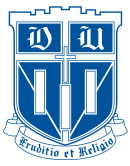 |
| 校训 |
Eruditio et Religio (拉丁语) |
| 英语校训 |
Knowledge and Faith |
| 建立于 |
1838 |
| 类型 |
Private |
| 捐赠 |
$4.44 billion |
| 校长 |
Richard H. Brodhead |
| 教职员工 |
2,877 |
| 学生 |
13,457 |
| 本科生 |
6,400 |
| 研究生 |
7,262 |
| 位置 |
Durham, North Carolina, US
36°0′4″N 78°56′20″W / 36.00111°N 78.93889°W / 36.00111; -78.93889Coordinates: 36°0′4″N 78°56′20″W / 36.00111°N 78.93889°W / 36.00111; -78.93889 |
| 校园 |
Urban
8,610 acres (34.8 km) |
| 曾用名 |
Brown School (1838–1841)
Union Institute (1841–1851)
Normal College (1851–1859)
Trinity College (1859–1924) |
| 颜色 |
Duke blue and white
|
| 昵称 |
Blue Devils |
| 体育运动 |
NCAA Division I FBS; ACC
26 varsity teams |
| 网址 |
www.duke.edu |

|
Duke University is a private research university located in Durham, North Carolina, United States. Founded by Methodists and Quakers in the present-day town of Trinity in 1838, the school moved to Durham in 1892. In 1924, tobacco industrialist James Buchanan Duke established The Duke 捐赠, prompting the institution to change its name in honor of his deceased father, Washington Duke. The University is organized into three undergraduate and ten graduate schools. In its 2010 edition, U.S. News & World Report ranked the university's undergraduate program 10th among national universities, while ranking the medical, law, and business schools among the top 14 in the United States. Duke University ranked 14th in the 2009 THES - QS World University Rankings.
Duke's research expenditures are among the largest ten in the U.S. Competing in the Atlantic Coast Conference, Duke's athletic teams have won 119 ACC Championships and eleven national championships, including four by its men's basketball team.
Besides academics, research, and athletics, Duke is also well known for its sizable campus and Gothic architecture, especially the Duke Chapel. The forests surrounding parts of the campus belie the University's proximity to downtown Durham. Duke's 8,610 acres (35 km) contain three contiguous campuses in Durham as well as a marine lab in Beaufort. Construction projects have updated both the freshmen-populated Georgian-style East Campus and the main Gothic-style West Campus, as well as the adjacent Medical Center over the past five years.
历史
Main article: History of Duke University
Beginnings
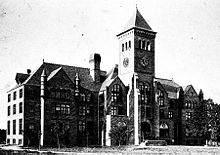
One of the first buildings on the original Durham campus (East Campus), the Washington Duke Building ("Old Main") was destroyed by a fire in 1911.
Duke started as Brown's Schoolhouse, a private subscription school founded in 1838, in Randolph County in the present-day town of Trinity. Brown's Schoolhouse was organized by the Union Institute Society, a group of Methodists and Quakers, and in 1841 North Carolina issued a charter for Union Institute Academy. The academy was renamed Normal College in 1851 and then Trinity College in 1859 because of support from the Methodist Church. In 1892, Trinity moved to Durham, largely due to generosity from Washington Duke and Julian S. Carr, powerful and respected Methodists who had grown wealthy through the tobacco industry. Washington Duke gave what was then known as Trinity College a $100,000 endowment in 1896, with the stipulation that the college "open its doors to women, placing them on an equal footing with men."
In 1924, Washington Duke's son, James B. Duke, established The Duke 捐赠 with a $40 million ($434 million in 2005 dollars) trust fund. The annual income of the fund was to be distributed to hospitals, orphanages, the Methodist Church, three colleges, and Trinity College. William Preston Few, the president of Trinity College, insisted that the university be named Duke University, and James B. Duke agreed that it would be a memorial to his father. Money from the endowment allowed the University to grow quickly. Duke's original campus (East Campus) was rebuilt from 1925 to 1927 with Georgian-style buildings. By 1930, the majority of the Gothic style buildings on the campus one mile (1.6 km) west were completed, and construction on West Campus culminated with the completion of Duke Chapel in 1948.
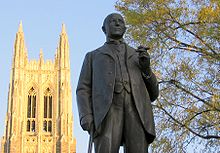
James B. Duke established the Duke 捐赠, which provides funds to numerous institutions including Duke University.
Expansion and growth
Engineering, which had been taught since 1903, became a separate school in 1939. In athletics, Duke hosted and competed in the only Rose Bowl ever played outside California in Wallace Wade Stadium in 1942. Increased activism on campus during the 1960s prompted Dr. Martin Luther King, Jr. to speak at the University on the civil rights movement's progress on November 14, 1964. The former governor of North Carolina, Terry Sanford, was elected president in 1969, propelling the Fuqua School of Business's opening, the William R. Perkins library completion, and the founding of the Institute of Policy Sciences and Public Affairs (now the Sanford School of Public Policy). The separate Woman's College merged back with Trinity as the liberal arts college for both men and women in 1972. Beginning in the 1970s, Duke administrators began a long-term effort to strengthen Duke's reputation both nationally and internationally. Interdisciplinary work was emphasized, as was recruiting minority faculty and students. Duke University Hospital was finished in 1980 and the student union was fully constructed two years later. In 1986, the men's soccer team captured Duke's first NCAA championship, and the men's basketball team shortly followed with championships in 1991 and 1992.
Recent history
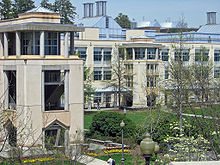
The Levine Science Research Center is the largest single-site interdisciplinary research facility of any American university.
Duke University's growth and academic focus have contributed to the university's reputation as an academic and research institution. The school has regularly sent three-member teams to the William Lowell Putnam Mathematical Competition, earning the title of the best collegiate undergraduate math team in the United States and Canada in 1993, 1996 and 2000. In recent years Duke's team has regularly finished in the top three.
Construction continued on campus, with the 314,000-square-foot (29,200 m) Levine Science Research Center (LSRC) opening in 1994 to house interdisciplinary research. These projects have updated both the freshmen-housed Georgian-style East Campus and the main Gothic-style West Campus, as well as the adjacent Medical Center in the past five years. Other projects are underway on all three campuses, including a 50- to 75-year overhaul of Central Campus.
In 1998, Duke President Nan Keohane initiated a five-year $1.5 billion Campaign for Duke fundraising effort. Edmund T. Pratt, Jr. ('47) endowed the Pratt School of Engineering with a $35 million gift in 1999. The Campaign for Duke ended in 2003 with $2.36 billion raised, making it the fifth largest campaign in the history of American higher education.
In the 2007 fiscal year, research expenditures surpassed $781 million, with the largest portions in health care and the life sciences. The first working demonstration of an invisibility cloak was unveiled by Duke researchers in October 2006. In 2002 and 2006, three students were named Rhodes Scholars, a number surpassed by only one other university both years. Overall, Duke has produced 42 Rhodes Scholars, including 21 in the past 15 years.
In August 2005, Duke established a partnership with the National University of Singapore to develop a joint medical program, which had its first entering class in 2007. In 2006, three lacrosse team members were accused of rape. Charges against the players were later dropped and the initial prosecutor was disbarred for ethical improprieties. The incident garnered significant media attention.
校园
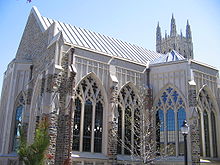
Part of the Divinity School addition, Goodson Chapel
Duke University owns 220 buildings on 8,610 acres (35 km) of land, which includes the 7,200 acre (29 km²) Duke Forest. The campus is divided into four main areas: West, East, and Central campuses, and the Medical Center. All the campuses are connected via a free bus service or the Duke University Medical Center Patient Rapid Transit people mover. On the Atlantic coast in Beaufort, Duke owns 15 acres (61,000 m) as part of its Marine Lab. One of the major public attractions on the Duke Campus is the 55-acre (220,000 m) Sarah P. Duke Gardens, established in the 1930s.
Duke students often refer to the campus as "the Gothic Wonderland," a nickname referring to the Gothic revival architecture of West Campus. Much of the campus was designed by Julian Abele, one of the first prominent African American architects. The residential quadrangles are of an early and somewhat unadorned design, while the buildings in the academic quadrangles show influences of the more elaborate late French and Italian styles. Its freshman campus (East Campus) is composed of buildings in the Georgian architecture style.
The stone used for the West Campus has seven primary colors and seventeen shades of color. The university supervisor of planning and construction wrote that the stone has "an older, more attractive antique effect" and a "warmer and softer coloring than the Princeton stone" that gave the university an "artistic look". James B. Duke initially suggested the use of stone from a quarry in Princeton, New Jersey, but later amended the plans to use stone from a local quarry which was purchased in Hillsborough to reduce costs. Duke Chapel stands at the heart of West Campus. Constructed from 1930 to 1935, the chapel seats 1,600 people; and, at 210 feet (64 m), is one of the tallest buildings in Durham County.
As of November 1, 2005, Duke had spent $835 million on 34 major construction projects initiated since February 2001. At that time, Duke initiated a five-year strategic plan, "Building on Excellence." Completed projects since 2002 include major additions to the business, law, nursing, and divinity schools, a new library, an art museum, a football training facility, two residential buildings, an engineering complex, a public policy building, an eye institute, two genetic research buildings, a student plaza, the French Family Science Center, and two new medical-research buildings.
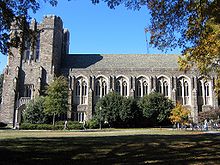
The Gothic Reading Room of Perkins Library
Libraries and museums
Main articles: Duke University Library System and Nasher Museum of Art
With more than six million volumes, the Duke University Library System is one of the ten largest private research university library systems in the U.S. and is the 22nd largest among members of the Association of Research Libraries. In addition to the six million volumes there are 17.7 million manuscripts, 1.2 million public documents, and tens of thousands of films and videos. Besides the main William R. Perkins Library complex, the university library system also includes the separately administered Ford (business), Divinity School, Goodson Law, and Medical Center Libraries.
The William R. Perkins Library system comprises the Perkins Library complex (Perkins Library, Bostock Library, Rare Book, Manuscript, and Special Collections Library and University Archives, and the von der Heyden Pavilion), Lilly Library (which houses materials on fine arts, philosophy, film & video, and performing arts), the Music Library, and the Pearse Memorial Library (located at the Marine Lab).
Nasher Museum of Art was designed by Rafael Viñoly and is named for Duke alumnus and art collector Raymond Nasher. The museum opened in 2005 at a cost of over $23 million, and contains over 13,000 works of art, including works by Andy Warhol, Barkley L. Hendricks, Christian Marclay, Dario Robleto and Kara Walker.
West, East, and Central Campuses
See also: Duke Chapel
West Campus, the heart of Duke University, houses all the sophomores, along with some juniors and seniors. In addition, most of the academic and administrative centers reside there. Main West Campus, with Duke Chapel at its center, contains the majority of residential quads to the south, while the main academic quad, library, and Medical Center are to the north. The campus, spanning 720 acres (2.9 km), includes Science Drive, which consists of science and engineering buildings. Most of the campus eateries and sports facilities including the historic basketball stadium, Cameron Indoor Stadium, are on West.

The main West Campus is dominated by Gothic architecture. Shown here are typical residence halls.
|
East Campus, the original location of Duke University, functions as a freshman campus as well as the home of several academic departments. Since the 1995-96 academic year, all freshmen—and only freshmen except for upperclassmen serving as Resident Assistants—have lived on East Campus, to build class unity. The campus encompasses 97 acres (390,000 m) and is 1.5 miles (2.4 km) away from West Campus. The Art History, History, Literature, Music, Philosophy, and Women's Studies Departments are housed on East. Programs such as dance, drama, education, film, and the University Writing Program also reside on East. East Campus, a fully self-sufficient campus, contains the freshman dormitories, a dining hall, Lilly Library, Baldwin Auditorium, a theater, Brodie Gym, tennis courts, and several academic buildings. Separated from downtown by a short walk, the area was the site of the Women's College from 1930 to 1972.

East Campus, home to all Duke freshmen, features Georgian architecture. Baldwin Auditorium can be seen on the right side.
|
Central Campus, consisting of 122 acres (0.49 km) between East and West campuses, houses around 850 juniors and seniors and 200 professional students in apartments. It is home to the Nasher Museum of Art, the Freeman Center for Jewish Life, the Duke Police Department, the Duke Office of Disability Management, a Ronald McDonald House, and administrative departments such as Duke Residence Life and Housing Services. Central has several recreation and social facilities such as basketball courts, tennis courts, a sand volleyball court, barbecue grills and picnic shelters, a general gathering building called Devil's Den, and a convenience store.
At present, there is a 20- to 50-year plan to restructure Central Campus. The idea is to develop an "academic village" as a key center for the Duke community. The first phase, costing $240 million, involves replacing the outdated apartments. Other additions in the first phase include dining, academic, recreational, and service facilities. A key goal of the Central renovations is to reintegrate the area with the rest of the Duke campus, as it is connected to the other campuses by a circuitous, inefficient bus route.
Key places
Main articles: Duke Lemur Center, Duke University Medical Center, and Sarah P. Duke Gardens
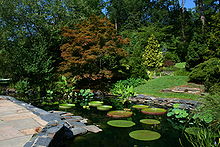
The Sarah P. Duke Gardens attract more than 300,000 visitors each year.
Duke Forest, established in 1931, today consists of 7,200 acres (29 km²) in six divisions, just west of Duke University's West Campus. It is one of the largest continually managed forests in the U.S. and demonstrates a variety of forest stand types and silvicultural treatments. Duke Forest is used extensively for research and includes the Aquatic Research Facility, Forest Carbon Transfer and Storage (FACTS-I) research facility, two permanent towers suitable for micrometerological studies, and other areas designated for animal behavior and ecosystem study. More than 30 miles (48 km) of trails are open to the public for hiking, cycling, and horseback riding.
The Duke Lemur Center, located inside the Duke Forest, is the world's largest sanctuary for rare and endangered prosimian primates. Founded in 1966, the Duke Lemur Center spans 85 acres (3.44 km²) and contains nearly 300 animals of 25 different species of lemurs, galagos and lorises.
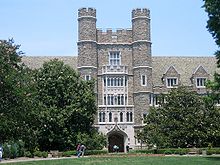
Entrance to the Medical Center from West Campus
The Sarah P. Duke Gardens, established in the early 1930s, is situated between West Campus and the apartments of Central Campus. The gardens occupy 55 acres (2.2 km²), divided into four major sections: the original Terraces and their surroundings; the H.L. Blomquist Garden of Native Plants, devoted to flora of the Southeastern United States; the W.L. Culberson Asiatic Arboretum, housing plants of Eastern Asia, as well as disjunct species found in both Eastern Asia and Eastern North America; and the Doris Duke Center Gardens. There are five miles (8 km) of allées and paths throughout Gardens.
Duke University Medical Center, located directly north of West Campus, combines one of the top-rated hospitals and one of the top-ranked medical schools in the U.S. Founded in 1930, the Medical Center occupies 7.5 million square feet (700,000 m²) in 91 buildings on 210 acres (8.5 km²).
Duke University Marine Lab, although located in the town of Beaufort, North Carolina, is also part of Duke's campus. The marine lab is situated on Pivers Island on the Outer Banks of North Carolina, only 150 yards (140 m) across the channel from Beaufort. Duke's interest in the area began in the early 1930s and the first buildings were erected in 1938. The resident faculty represent the disciplines of oceanography, marine biology, marine biomedicine, marine biotechnology, and coastal marine policy and management. The Marine Laboratory is a member of the National Association of Marine Laboratories (NAML).
学术
Profile
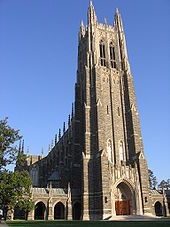
Duke Chapel, a frequent icon for the university, can seat nearly 1,600 people and contains a 5,200-pipe organ
Duke's student body consists of 6,340 undergraduates and 7,117 graduate and professional students (as of Fall 2008). The undergraduate student body, of whom 40% are members of ethnic minorities, come from all 50 U.S. states and 106 countries (as of 2007-08). For the undergraduate class of 2014, Duke received 26,770 applications, and accepted 14.8% of them. For the class of 2012, 96% of admitted students ranked in the top 10% of their high school class. The middle 50% range of SAT scores for first-year students is 1340-1540 (old scale) or 2020-2320 (new scale), while the ACT range is 29-34. In 2007 the School of Medicine received 5,076 applicants for 100 spots (2.0% of applicants), while the average GPA and MCAT scores for accepted students were 3.88 and 36, respectively. The School of Law accepted approximately 18% of its applicants for the Class of 2012, while enrolling students had a median GPA of 3.76 and median LSAT of 169.
Demographics of student body
|
Undergraduate |
Graduate |
U.S. Census |
| African American |
10% |
7.5% |
12.1% |
| Asian American |
22% |
8.5% |
4.3% |
Non-Hispanic
White American |
47% |
55% |
68% |
| Hispanic American |
7% |
3.5% |
14.5% |
| Other/Unknown |
8% |
8% |
N/A |
| International student |
7% |
18% |
N/A |
Duke University has two schools for undergraduates: Trinity College of Arts and Sciences and Pratt School of Engineering. The University's graduate and professional schools include the Graduate School, the Pratt School of Engineering, the Nicholas School of the Environment, the School of Medicine, the School of Nursing, the Fuqua School of Business, the School of Law, the Divinity School, and the Sanford School of Public Policy.
In the past decade, Duke has had the sixth highest number of Fulbright, Rhodes, Truman, and Goldwater scholarships in the nation among private universities. The University practices need-blind admissions and meets 100% of admitted students' demonstrated need. More than 40% of students in 2007–08 received financial aid, with the average grant being $26,700. Roughly 60 merit-based scholarships are also offered, the most prestigious of which is the Angier B. Duke Memorial Scholarship, awarded for academic excellence. Other scholarships are geared toward students in North Carolina, African-American students, and high achieving students requiring financial aid.
Duke University's endowment had a market value of $4.4 billion in the fiscal year ended June 30, 2009. The University's special academic facilities include an art museum, several language labs, the Duke Forest, the Duke Herbarium, a lemur center, a phytotron, a free electron laser, a nuclear magnetic resonance machine, a nuclear lab, and a marine lab. Duke also is a leading participant in the National Lambda Rail Network and runs a program for gifted children known as the Talent Identification Program, or TIP.
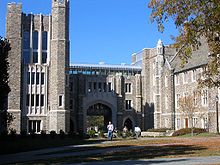
Entrance to Duke's Bostock Library, which opened in the fall of 2005
Undergraduate
Duke offers 36 arts and sciences majors, four engineering majors, and 46 additional majors that have been approved under Program II, which allows students to design their own interdisciplinary major. Sixteen certificate programs also are available. Students may pursue a combination of a total of up to three majors/minors/certificates. Eighty percent of undergraduates enroll in the Trinity College of Arts and Sciences, while the rest are in the Pratt School of Engineering.
Trinity's curriculum operates under the revised version of "Curriculum 2000." It ensures that students are exposed to a variety of "areas of knowledge" and "modes of inquiry." The curriculum aims to help students develop critical faculties and judgment by learning how to access, synthesize, and communicate knowledge effectively, acquiring perspective on current and historical events, conducting research and solving problems, and developing tenacity and a capacity for hard and sustained work. In addition, freshmen can elect to participate in the FOCUS Program, which allows students to engage in an interdisciplinary exploration of a specific topic in a small group setting.
Pratt's curriculum, on the other hand, is narrower in scope, but still accommodates double majors in a variety of disciplines. The school emphasizes undergraduate research—opportunities for hands-on experiences arise through internships, fellowship programs, and the structured curriculum. Furthermore, for the class of 2007, more than 27% of Pratt undergraduates studied abroad, small compared to the percentage for Trinity undergraduates (46%), but much larger than the national average for engineering students (1.5%).
Research
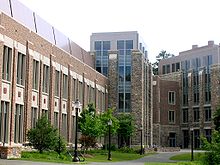
The Fitzpatrick Center is home to many of Duke's engineering programs.
In the 2007 fiscal year, research expenditures surpassed $781 million, mostly in health care and life sciences. In the 2005 fiscal year, Duke University Medical Center received the fifth-largest amount of funding from the National Institute of Health, netting $349.8 million. Duke's funding increased 14.8% from 2004, representing the largest growth of any top-20 recipient. In the 2008 fiscal year, Duke University School of Nursing jumped to 18th nationally in the rankings of the National Institute of Health funding for nursing schools, netting more than $2.34 million, up 54 percent from 2007, when it ranked 30th nationally.
Throughout history, Duke researchers have made breakthroughs, including the biomedical engineering department's development of the world's first real-time, three-dimensional ultrasound diagnostic system and the first engineered blood vessels. In the mechanical engineering department, Adrian Bejan developed the constructal theory, which explains the shapes that arise in nature. Duke has also pioneered studies involving nonlinear dynamics, chaos, and complex systems in physics. In May 2006, Duke researchers mapped the final human chromosome, which made world news as the Human Genome Project was finally complete. Reports of Duke researchers' involvement in new AIDS vaccine research surfaced in June 2006. The biology department combines two historically strong programs in botany and zoology, while one of the divinity school's leading theologians is Stanley Hauerwas, whom Time named "America's Best Theologian" in 2001. The graduate program in literature boasts several internationally renowned figures, including Fredric Jameson, and Michael Hardt, while philosophers Robert Brandon and Lakatos Award-winner Alexander Rosenberg make Duke a leading center for research in philosophy of biology.
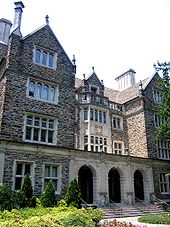
Built in 1932, Old Chemistry has scientific symbols carved above the main doorway
Rankings
|
|
University rankings (overall)
|
|
| ARWU World |
32 |
| ARWU North & Latin America |
24 |
| Times Higher Education |
14 |
| USNWR National University |
10 |
| WM National University |
29 |
In the 2010 U.S. News & World Report ranking of undergraduate programs at doctoral granting institutions, Duke ranked 10th. In the past decade, U.S. News & World Report has placed Duke as high as 3rd and as low as 10th. Duke was ranked the 14th-best university in the world in 2009 by the THES - QS World University Rankings. Duke was ranked 32nd best globally and 25th nationally by Shanghai Jiao Tong University in 2008, focusing on quality of scientific research and number of Nobel Prizes. The Wall Street Journal ranked Duke 6th (5th among universities) in its "feeder" rankings in 2006, analyzing the percentage of undergraduates that enroll in what it considers the top 5 medical, law, and business schools. A survey by the Journal of Blacks in Higher Education in 2002 ranked Duke as the best university in the country in regard to the integration of African American students and faculty.
In U.S. News & World Report 's "America's Best Graduate Schools 2009," Duke's medical school ranked 6th for research and tied for 41st for primary care, while the law school ranked 10th. Duke's nursing school tied for 15th in U.S. News & World Report's 2007 rankings, while the Sanford School of Public Policy tied for 10th in 2008 for national public affairs programs. Among business schools in the United States, the Fuqua School of Business was ranked 12th by U.S. News & World Report in 2009 and 8th by BusinessWeek in 2008. The graduate program for the Pratt School of Engineering was ranked 30th by U.S. News & World Report and 2nd by The Princeton Review in 2006 among national engineering schools. In the rankings of doctoral programs by U.S. News & World Report in its 2008 edition, Duke ranked 1st in literary criticism and theory, 5th in ecology and evolutionary biology, 5th in biomedical engineering, tied for 6th in statistics, tied for 12th for doctoral programs in the sciences, tied for 20th in computer science, tied for 21st in mathematics, tied for 29th in physics, tied for 34th in earth sciences, and ranked 38th in chemistry.
Political science, sociology, history, economics, and cultural anthropology departments also frequently rank in the top 20 of their respective disciplines among U.S. universities. The Philosophical Gourmet Report placed Duke's philosophy program as the 27th best in the nation in 2006, while ranking Duke as the best program in the U.S. in philosophy of biology.
Student life
Residential life
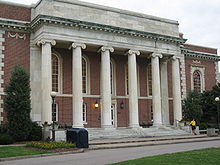
East Campus' Union building, home to the freshman dining hall
Duke requires its students to live on campus for the first three years of undergraduate life, except for a small percentage of second semester juniors who are exempted by a lottery system. This requirement is justified by the administration as an effort to help students connect more closely with one another and sustain a sense of belonging within the Duke community. Thus, 85% of undergraduates live on campus. All freshmen are housed in one of 14 residences on East Campus. These buildings range in occupancy size from 50 (Epworth—the oldest dorm, built in 1892 as "the Inn") to 190 residents (Gilbert-Addoms). Most of these are in the Georgian style typical of the East Campus architecture. Although the newer residence halls differ in style, they still relate to East’s Georgian heritage. Two learning communities, the Performing Arts Community and East Campus Wellness, connect the residential component of East Campus with students of similar academic and social interests. Similarly, students in the Focus program, a first-year program that features courses clustered around a specific theme, live together in the same residence halls.
The vast majority of sophomores reside on West Campus, but they may also elect to live on Central Campus. Juniors and seniors can choose to live on West or Central. West Campus contains six quadrangles—the four along "Main" West were built in 1930’s, while two newer ones have since been added. West Campus is home to three learning communities including West Campus Wellness, a substance-free section, and the Baldwin Scholars program. These groups are allocated "sections" of the quadrangles, thereby living close to one another, but still within the context of a larger community. Also, 25 "selective living groups" are housed within sections on West, including 15 fraternities. Nine of the 11 non-fraternity selective living groups are coeducational. Central Campus provides housing for approximately 1,050 students (of which about 850 are undergraduate juniors or seniors) in 45 apartment buildings. About half of Duke seniors, however, choose to live off campus.
Greek and social life
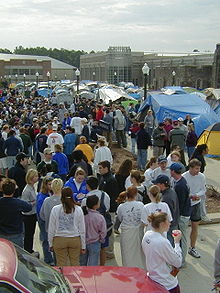
Cameron Crazies gathering in K-ville
About 30% of undergraduate men and about 40% of undergraduate women at Duke are members of fraternities and sororities. Some of the 15 Interfraternity Council (IFC) recognized fraternity chapters live in sections within West Campus quads, while the others and the 9 Panhellenic Association Sorority Chapters feature residential communities in the Central Campus apartments. Eight National Pan-Hellenic Council (historically African American) fraternities and sororities also hold chapters at Duke. In addition, four other fraternities and sororities form the Inter-Greek Council, the multicultural Greek umbrella organization. Duke also has 11 Selective Living Groups, or SLGs, on campus for students wanting self-selecting living arrangements. Selective Living Groups at Duke are residential groups similar to fraternities or sororities but are generally co-ed, housed on West Campus, and unaffiliated with any national organizations. Fraternity chapters frequently host social events in their residential sections, which are often open to non-members.
In the late-1990s, a new keg policy was put into effect that requires all student groups to purchase kegs through Duke Dining Services. According to administrators, the rule change was intended as a way to ensure compliance with alcohol consumption laws as well as to increase on-campus safety. Some students saw the administration's increasingly strict policies as an attempt to alter social life at Duke. As a result, off-campus parties at rented houses became more frequent in subsequent years as a way to avoid Duke policies. Many of these houses were situated in the midst of family neighborhoods, prompting residents to complain about excessive noise and other violations. Police have responded by breaking up parties at several houses, handing out citations, and occasionally arresting party-goers. The administration has been very active in the past few years with efforts to help students re-establish a robust, on-campus social life and has worked with numerous student groups, especially the Duke University Union, to feature a wide array of events and activities. In March 2006, the university also purchased 15 houses in the Trinity Park area that Duke students had typically rented. These houses are now owned by individual families who live in them, including the Dean of Duke Chapel.
Duke athletics, particularly basketball, is a significant component of Duke's student life. Duke's students have been recognized as some of the most creative and original fans in all of collegiate athletics. Students, often referred to as Cameron Crazies, show their support of the men's basketball team by "tenting" for home games against key ACC rivals, especially UNC. Because tickets to all varsity sports are free to students, they line up for hours before each game, often spending the night on the sidewalk. For a mid-February game against UNC, some of the most eager students might even begin tenting before spring classes begin. The total number of participating tents is capped at 100 (each tent can have up to 12 occupants), though interest is such that it could exceed that number if space permitted. Tenting involves setting up and inhabiting a tent on the grass near Cameron Indoor Stadium, an area known as Krzyzewskiville, or K-ville for short. There are different categories of tenting based on the length of time and number of people who must be in the tent. At night, K-ville often turns into the scene of a party or occasional concert. The men's basketball coach, Mike Krzyzewski, is known to buy pizza on occasion for the inhabitants of the tent village.
Activities
Student organizations
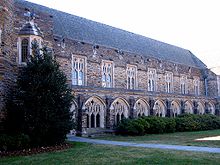
Duke's West Campus Union building has restaurants, offices, and some administrative departments. The Chronicle's administrative office, the Mary Lou Williams Center for Black Culture, and the Center for LGBT Life are all located in the Union.
Approximately 370 student clubs and organizations operate on Duke's campus. These include numerous student government, special interest, and service organizations. Chartered by the Board of Trustees, the most prominent amongst these are the Duke Student Government, the Duke University Union, and Campus Council. Duke Student Government (DSG) subsequently charters and provides most of the funding for other student groups, and represents students' interests when dealing with the administration. The Duke University Union (DUU) is the school's primary programming organization, serving a center of social, cultural, intellectual and recreational life. Campus Council is the school's residential student government, specializing in programming, policy, and facilities and services. Cultural groups are also provided funding directly from the university via the Multicultural Center as well as other institutional funding sources. One of the most popular activities on campus is competing in sports. Duke has 35 sports clubs and 29 intramural teams that are officially recognized. Performance groups such as Hoof 'n' Horn, the South's oldest student-run musical theater organization, a cappella groups such as the Duke Pitchforks, student bands such as Alan Davis Band, and Duke University Improv are also prominent on campus. The Duke University Student Dining Advisory Committee, or DUSDAC, provides guidance to the administration on issues regarding student dining, life, and restaurant choices.
Cultural groups on campus include: the Asian Students Association, Blue Devils United (the student lesbian, gay, bisexual and transgender group), Black Student Alliance, Diya (South Asian Association), Jewish Life at Duke, Mi Gente (Latino Student Association), International Association/International Council, Muslim Student Association, Native American Student Coalition, Newman Catholic Student Center, Languages Dorm, and Students of the Caribbean.
Civic engagement
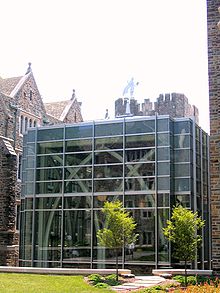
The von der Heyden Pavilion is a popular place among students for gathering and studying.
According to The Princeton Review, Duke is one of 81 institutions in the country with outstanding community service programs. In 2008, Duke received the Community Engagement Classification from Carnegie Foundation for the Advancement of Teaching. In February 2007, Duke launched DukeEngage, a $30 million civic engagement program that allows undergraduates to participate in an in-depth service opportunity over the course of a summer or semester. The program's scope has been called "unprecedented in U.S. higher education." In addition, Duke students have created more than 30 service organizations in Durham and the surrounding area. Examples include a weeklong camp for children of cancer patients (Camp Kesem) and a group that promotes awareness about sexual health, rape prevention, alcohol and drug use, and eating disorders (Healthy Devils). The Duke-Durham Neighborhood Partnership, started by the Office of Community Affairs in 1996, attempts to address major concerns of local residents and schools by leveraging university resources. Another community project, "Scholarship with a Civic Mission," is a joint program between the Hart Leadership Program and the Kenan Institute for Ethics. Other programs include: Project CHILD, a tutoring program involving 80 first-year volunteers; an after-school program for at-risk students in Durham that was started with $2.25 million grant from the Kellogg Foundation in 2002; and Project BUILD, a freshman volunteering group that dedicates 3300 hours of service to a variety of projects such as schools, Habitat for Humanity, food banks, substance rehabilitation centers, and homeless shelters. Some courses at Duke incorporate service as part of the curriculum to augment material learned in class such as in psychology or education courses (known as service learning courses).
Student media
See also: The Chronicle, Cable 13, and WXDU
The Chronicle, Duke's independent undergraduate daily newspaper, has been continually published since 1905 and has a readership of about 30,000. Its editors are responsible for selecting the term "Blue Devil." The newspaper won Best in Show in the tabloid division at the 2005 Associated Collegiate Press National College Media Convention. Cable 13, established in 1976, is Duke's student-run television station. It stands as a popular activity for students interested in film production and media. WXDU-FM, licensed in 1983, is the University's nationally recognized, noncommercial FM radio station, operated by student and community volunteers.
体育运动
Main article: Duke Blue Devils
See also: Carolina-Duke rivalry
Duke's 26 varsity sports teams, known as the Blue Devils, are members of the NCAA's Division I Atlantic Coast Conference. The Blue Devil Mascot's origins are rooted in an elite French alpine fighting unit that garnered accolades and much global attention during World War I and its aftermath. The French fighters' uniforms consisted of a flowing blue cape and blue beret. Athletic teams at the school had no moniker until approximately 1924 when the school's newspaper, The Trinity Chronicle, decided upon "Blue Devils" as the name after a much maligned democratic effort to select a name in the previous year. Students initially feared that the Methodist school's administration might frown upon the choice given the religious environment, but were surprised when there was virtually zero opposition to the reference. Although hardly anyone today knows of the elite French fighting force, "les Diables Bleus," Duke's mascot origin is considered to be military and patriotic rather than anti-religious.
Duke's teams have won eleven NCAA team national championships—the women's golf team has won five (1999, 2002, 2005, 2006 and 2007), the men's basketball team has won four (1991, 1992, 2001, and 2010), and the men's soccer (1986) and women's tennis (2009) teams have won one each. Historically, Duke's major rival has been the Tar Heels of the University of North Carolina at Chapel Hill, especially in basketball. The rivalry has led people to identify the two differing shades of blue in relation to their respective university—calling the lighter powder blue "Carolina blue" and the darker blue "Duke blue."
In the past ten years, Duke has finished in the top 30 every year in the NACDA Directors' Cup, an overall measure of an institution's athletic success. In the past three years, Duke has finished 11th (2007), eighth (2006), and fifth (2005). Duke teams that have been ranked in the top ten nationally in the 2000s include men's and women's basketball, men's and women's tennis, men's and women's soccer, men's and women's fencing, men's and women's cross country running, men's and women's lacrosse, women's field hockey, and men's and women's golf. Eight of these teams were ranked either first or second in the country during 2004–05. Women's golf has been particularly dominating, compiling a record of 796-45-3 (.945) in the 2000–2005 seasons. Duke has won 112 ACC Championships, 42 of which have come since 1999-2000 (through 2008-09). The men's lacrosse program has been one of the most successful in the nation recently—it has ranked in the top 15 in the country in five of the last six last participating seasons and reached the national championship game in 2005 and 2007, losing to The Johns Hopkins University by a single goal and accumulating season records of 17-3 both times.
According to a 2006 evaluation conducted by the NCAA, Duke's student-athletes have the highest graduation rate of any institution in the nation. In 2005, 2006, and 2007, Duke ranked first among Division I schools in the National Collegiate Scouting Association Power Rankings—a combination of the institution's Director's Cup standing, its athletic graduation rate, and its academic rank in U.S. News & World Report.
Men's basketball
Main article: Duke Blue Devils men's basketball
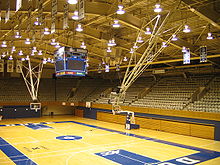
Duke's famous Cameron Indoor Stadium
Duke's men's basketball team is one of the nation's most successful basketball programs. The team has captured four National Championships (fifth place all time), while attending 15 Final Fours (third place overall) and 10 Championship games (tied for second place with Kentucky). Duke has the most Atlantic Coast Conference championships with 18 and has the most National Players of the Year in the nation with 11. Seventy-two players have been selected in the NBA Draft, while 32 players have been honored as All-Americans. Duke's program is one of only two to have been to at least one Final Four and one National Championship game in each of the past five decades. The program's home facility is historic Cameron Indoor Stadium, considered one of the top venues in the nation.
The team's success has been particularly outstanding over the past 30 years under coach Mike Krzyzewski (often simply called "Coach K") who also has coached the USA men's national basketball team since 2006 and led to team to Olympic gold in 2008. Their successes include becoming the only team to win four national championships since the NCAA Tournament field was expanded to 64 teams in 1985, 11 Final Fours in the past 25 years, and eight of nine ACC tournament championships from 1999 to 2006. Fourteen of its alumni play in the NBA as of the 2009 season, making Duke tied for the highest number among college teams.
Football
Main article: Duke Blue Devils football
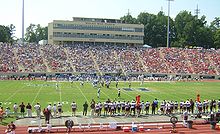
Wallace Wade Stadium, home to Duke football and site of the 1942 Rose Bowl
The Blue Devils have won seven ACC Football Championships, have had ten players honored as ACC Player of the Year (the most in the ACC), and have had three Pro Football Hall of Famers come through the program (second in the ACC to only Miami's four). In addition, the Blue Devils have produced 11 College Football Hall of Famers which is tied for the 2nd most in the ACC. Duke has also won 18 total conference championships (7 ACC, 9 Southern Conference, and 1 Big Five Conference). That total is the highest in the ACC.
The most famous Duke football season came in 1938, when Wallace Wade coached the "Iron Dukes" that shut out all regular season opponents; only three teams in history can claim such a feat. Duke reached their first Rose Bowl appearance, where they lost 7-3 when USC scored a touchdown in the final minute of the game. Wade's Blue Devils lost another Rose Bowl to Oregon State in 1942, this one held at Duke's home stadium due to the attack on Pearl Harbor, which resulted in the fear that a large gathering on the West Coast might be in range of Japanese aircraft carriers. The football program also proved successful in the 1950s and 1960s, winning six of the first ten ACC football championships from 1953 to 1962 under coach Bill Murray; the Blue Devils would not win the ACC championship again until 1989 under now revered coach Steve Spurrier.
Despite its long history of success at football, Duke has not had a winning season since 1994. David Cutcliffe was brought in two years ago as head coach, however, and he and his staff have been widely hailed as contributing to a turnaround that is currently in progress. The 2009 team won 5 of 12 games and was eliminated from bowl contention in the next-to-last game of the season. Typical of the external recognition given the team is the fact that Mike MacIntyre, the defensive coordinator, was named 2009 Assistant Coach of the Year by the American Football Coaches Association
While the football team has struggled at times on the field, the graduation rate of its players is consistently among the highest among Division I-A schools. Duke's high graduation rates have earned it more American Football Coaches Association's Academic Achievement Awards than any other institution.
[edit] Alumni
Main article: List of Duke University people
Duke alumni are active through organizations and events such as the annual Reunion Weekend and Homecoming. There are 75 Duke clubs in the U.S. and 38 international clubs. For the 2005–06 fiscal year, Duke tied for third in alumni giving rate among U.S. colleges and universities. A number of Duke alumni have made significant contributions in the fields of government, law, science, academia, business, arts, journalism, and athletics, among others.
Richard Nixon, 37th President of the United States graduated with a law degree in 1937. Elizabeth Dole, former United States Senator from North Carolina and former President of the American Red Cross, Ricardo Lagos, 33rd President of Chile from 2000 to 2006, Ron Paul, Texas congressman and two-time presidential candidate, and Jeffrey Zients, the first United States Chief Performance Officer are among the most notable alumni with involvement in politics. In the research realm, Duke graduates who have won the Nobel Prize in Physics include Hans Dehmelt for his development of the ion trap technique, Robert Richardson for his discovery of superfluidity in helium-3, and Charles Townes for his work on quantum electronics.
Several alumni hold top positions at large companies. Current or recent Chairman, 校长, Vice president, or CEO of each of the following Fortune 500 companies is a Duke alumnus: BB&T (John A. Allison IV), Boston Scientific Corporation (Peter Nicholas), Chesapeake Energy (Aubrey McClendon), Cisco Systems (John Chambers), ExxonMobil (Rex Adams), General Motors Corporation (Rick Wagoner), Medtronic (Bill Hawkins), Morgan Stanley (John J. Mack), Norfolk Southern (David R. Goode), Northwest Airlines (Gary L. Wilson), PepsiCo, Inc. (Karl von der Heyden), Pfizer (Edmund T. Pratt, Jr.), and Wachovia (Robert K. Steel). Kevin Martin is Chairman of the FCC, and Rex Adams serves as the Chairman of PBS. Another alumna, Melinda Gates, is the co-founder of the $31.9 billion Bill & Melinda Gates Foundation, the nation's wealthiest charitable foundation.
Prominent journalists include Sean McManus, who is president of both CBS Sports and CBS News. Dan Abrams is chief legal correspondent for NBC News, while Charlie Rose hosts his own talk show. Judy Woodruff is a senior correspondent for The NewsHour with Jim Lehrer on PBS and was formerly NBC's White House correspondent and an anchor for CNN. Jay Bilas is a basketball analyst for ESPN who co-hosts College GameDay, and also joins CBS as a game analyst for the NCAA Men's Basketball Championship. Mike Gminski, Jim Spanarkel, and Jay Williams are also among the former basketball players who have become color commentators for the sport. John Feinstein writes columns for The Washington Post and has written multiple sports-oriented books. Rik Kirkland serves as a Managing Editor for the magazine Fortune, while Clay Felker is a founding editor of New York. John Harwood is the Chief Washington Correspondent for CNBC, a Senior Contributing Writer for The Wall Street Journal, and frequent panelist on Washington Week.
William C. Styron won the Pulitzer Prize for Fiction in 1968 for his novel The Confessions of Nat Turner and is also well-known for his 1979 novel Sophie's Choice and his 1992 memoir Darkness Visible. The Pulitzer Prize for Fiction was also awarded to Anne Tyler for her 1988 novel Breathing Lessons.
In the arts realm, Annabeth Gish (actress in the X-Files and The West Wing), Randall Wallace (screenwriter, producer, and director, Braveheart, Pearl Harbor, We Were Soldiers) and David Hudgins (television writer and producer, Everwood, Friday Night Lights) headline the list. Management of professional athletic franchises include John Angelos (Executive Vice President of the Baltimore Orioles), Aubrey McClendon (partial owner of the Oklahoma City Thunder), John Canning, Jr. (co-owner of Milwaukee Brewers), Danny Ferry (general manager of the Cleveland Cavaliers, and Stephen Pagliuca (co-owner of Boston Celtics). Finally, several athletes have become stars at the professional level, especially in basketball's NBA. Shane Battier, Corey Maggette, Elton Brand, Carlos Boozer, Chris Duhon, and Grant Hill, and J.J. Redick are among the most famous.
Notes
- ^ King, William E. "Shield, Seal and Motto". Duke University Archives. http://library.duke.edu/uarchives/history/histnotes/insignia.html. Retrieved 2008-05-23.
- ^ "Duke Divinity School - Overview". Divinity.duke.edu. http://www.divinity.duke.edu/about/index_html. Retrieved 2010-03-26.
- ^ As of June 30, 2009. "U.S. and Canadian Institutions Listed by Fiscal Year 2009 Endowment Market Value and Percentage Change in Endowment Market Value from FY 2008 to FY 2009" (PDF). 2009 NACUBO-Commonfund Study of Endowments. National Association of College and University Business Officers. http://www.nacubo.org/Documents/research/2009_NCSE_Public_Tables_Endowment_Market_Values.pdf. Retrieved February 11, 2010.
- ^ "Quick Facts about Duke". Duke Office of News & Communications. http://www.dukenews.duke.edu/resources/quickfacts.html. Retrieved 2008-05-23.
- ^ "Quick Facts about Duke". Duke Office of News & Communications. http://www.dukenews.duke.edu/resources/quickfacts.html. Retrieved 2010-02-01.
- ^ "The origin of Duke Blue". Duke University Archives. http://library.duke.edu/uarchives/faqs/duke_blue.html. Retrieved 2008-05-23.
- ^ King, William E. "Duke University: A Brief Narrative History". Duke University Archives. http://library.duke.edu/uarchives/history/narrativehistory.html. Retrieved 2008-05-23.
- ^ America's Best Colleges 2010. U.S. News & World Report, 2009. Retrieved on September 7, 2009.
- ^ America's Best Graduate Schools 2009. U.S. News & World Report, 2009. Retrieved on April 23, 2009.
- ^ "THES - QS World University Rankings 2009". The Times Higher Education Supplement. http://www.timeshighereducation.co.uk/Rankings2009-Top200.html. Retrieved 2009-12-17.
- ^ {{cite web|url=http://www.washingtonmonthly.com/college_guide/rankings/national_university_rank.php|title=The Washington Monthly National University Rankings |format=PDF | year=2009 |publisher=The Washington Monthly |accessdate=2010-04-23}
- ^ "A Chronology of Significant Events in Duke University's History". Duke University Archives. http://library.Duke.edu/uarchives/history/chronology.html. Retrieved 2008-05-23.
- ^ Pyatt, Tim (November-December 2006). Retrospective: Selections from University Archives. 92. Duke Office of Alumni Affairs. http://www.dukemagazine.duke.edu/dukemag/issues/111206/depret.html. Retrieved 2008-05-23.
- ^ Duke Annual Report 2000/2001-Interdisciplinary. Duke University Annual Report, 2001. Retrieved on January 12, 2007.
- ^ Rogalski, Jim. Breaking the Barrier: A History of African-Americans at Duke University School of Medicine. Inside DUMC, February 20, 2006. Retrieved on January 12, 2007.
- ^ Mock, Geoffrey. Duke's Black Faculty Initiative Reaches Goal Early. Duke University Office of News and Communication, November 21, 2002. Retrieved on January 12, 2007.
- ^ research.asp Research Opportunities & Grants. Duke University Admissions. Retrieved on January 12, 2007.
- ^ The Mathematical Association of America's William Lowell Putnam Competition. Mathematical Association of America. Retrieved on January 12, 2007.
- ^ Allison, Chelsea. Plans for new Central shift to south. The Chronicle, March 5, 2008. Retrieved on March 5, 2008.
- ^ Central Campus Planning: History and Timeline. Duke University: Central Campus Planning. Retrieved on March 5, 2008.
- ^ The Campaign for Duke. Robertson Scholars Program. Retrieved on January 12, 2007.
- ^ "Academic Research and Development Expenditures: Fiscal Year 2007"
- ^ Duke researchers unveil 'invisibility cloak' device. Chicago Tribune, October 20, 2006. Retrieved on January 12, 2007.
- ^ "Duke Graduate Julia Parker Goyer Named Rhodes Scholar". News.duke.edu. 2008-11-23. http://news.duke.edu/2008/11/rhodes.html. Retrieved 2010-03-26.
- ^ "Duke Nus". Gms.edu.sg. http://www.gms.edu.sg/. Retrieved 2010-03-26.
- ^ Beard, Aaron (2007-04-11). "Prosecutors Drop Charges in Duke Case". Associated Press. http://www.sfgate.com/cgi-bin/article.cgi?file=/n/a/2007/04/11/national/a113721D83.DTL. Retrieved 2008-05-23.
- ^ C2005 Fall Writing 20-89. Duke Online Course Synopsis Handbook. Retrieved on January 12, 2007.
- ^ Julian Abele, Architect. Duke University Archives. Retrieved on June 21, 2007.
- ^ King, William E. DukeStone. Duke University Historical Notes. Retrieved on January 12, 2007.
- ^ Duke Divinity School - Overview. Duke Divinity School. Retrieved on June 21, 2007.
- ^ Mueller, Jared. Campus reaps benefits of facilities boom. The Chronicle Online, November 1, 2005. Retrieved on January 12, 2007.
- ^ Dagger, Jacob. Stones, Bricks, and Mortar: Building for Success. Duke Magazine, March-April 2006. Retrieved on January 12, 2007.
- ^ The Nation's Largest Libraries. American Library Association, August 2005. Retrieved on January 12, 2007.
- ^ About Duke Libraries. Duke University Libraries. Retrieved on Feb. 5, 2010.
- ^ Duke Libraries. Duke University Libraries. Retrieved on June 21, 2007.
- ^ Nasher Museum of Art at Duke University. Nasher Museum of Art at Duke University. Retrieved on June 21, 2007.
- ^ RLHS: Housing. Duke Residence Life and Housing Services. Retrieved on January 12, 2007.
- ^ Cameron Indoor Stadium. Duke University. Retrieved on June 21, 2007.
- ^ "East Campus: History of East Campus". http://library.duke.edu/lilly/about/eastcampus.html. Retrieved June 21, 2007.
- ^ Central Campus. Duke Residence Life & Housing Services. Retrieved on June 21, 2007.
- ^ Duke University: Central Campus Planning. Duke University: Central Campus Planning, 2006. Retrieved on January 12, 2007.
- ^ Duke Forest. Duke Forest. Retrieved on June 21, 2007.
- ^ Duke University Admissions: Duke Forest. Duke Admissions. Retrieved on June 21, 2007.
- ^ Lillard, Margaret. Duke lemur center has new research focus. The Associated Press, June 4, 2006. Retrieved on June 21, 2007.
- ^ [1]. Duke Gardens. Retrieved on Nov. 24, 2009.
- ^ DukeMedNews. DukeMed News, June 1, 2006. Retrieved on June 21, 2007.
- ^ Duke University Marine Lab. Duke Marine Lab. Retrieved on June 21, 2007.
- ^ Class of 2010 Profile. Duke Admissions. Retrieved on March 4, 2007.
- ^ Class of 2009 Profile. Duke Admissions. Retrieved on March 4, 2007.
- ^ Duke's Class of 2012 Will Be Its Most Selective, Diverse — And Larger Than Expected. Duke Office of News & Communication. Retrieved on June 12, 2007.
- ^ Duke International House Statistics, 2007-08. Duke International House, 2008. Retrieved on May 28, 2008.
- ^ Khan, Naureen (2007-09-19). "So far away from home: International students find rifts, freedom at Duke". The Chronicle. http://media.www.dukechronicle.com/media/storage/paper884/news/2007/09/19/News/so.Far.Away.From.Home.International.Students.Find.Rifts.Freedom.At.Duke-2977643.shtml. Retrieved 2008-05-23.
- ^ College Search - Duke University. CollegeBoard. Retrieved on November 16, 2008.
- ^ Class of 2010 Profile. Duke Admissions. Retrieved on January 12, 2007.
- ^ Duke Mails Admissions Decisions to More than 19,000 Applicants for the Class Of 2010. Duke News & Communications. Retrieved on January 12, 2007.
- ^ Dagger, Jacob. Top of the Crop. Duke Magazine, February 2006. Retrieved on January 12, 2007.
- ^ Duke University School of Medicine. Admission Hub, 2007. Retrieved on December 9, 2007.
- ^ [2] Duke Law Admissions, 2009. Retrieved on Nov. 24, 2009.
- ^ "Quick Facts about Duke". Duke University. 2010. http://news.duke.edu/resources/quickfacts.html#students. Retrieved 2010-03-30.
- ^ See Demographics of the United States for references.
- ^ Duke homepage - Schools tab Duke University. Retrieved on June 12, 2007.
- ^ "Duke Gates Scholar 2007". Archived from the original on 2007-03-06. http://web.archive.org/web/20070306071512/http://trust.gatesscholar.org/scholars2007/zou.asp.
- ^ Twenty-two Duke Graduates, Grad Students Receive Fulbright Scholarships. Duke News & Communications, September 26, 2005. Retrieved on January 12, 2007.
- ^ Dunning, Denise (1996-03-22). "Trinity Juniors receive Truman scholarships". The Chronicle. http://media.www.dukechronicle.com/media/storage/paper884/news/1996/03/22/UndefinedSection/Trinity.Juniors.Receive.Truman.Scholarships-1442057.shtml. Retrieved 2008-05-23.
- ^ Duke Expands Financial Aid For Lower- And Middle-Class Families. Duke News & Communications, December 7, 2007. Retrieved on December 9, 2007.
- ^ Financial Aid Statistics. Duke Financial Aid. Retrieved on January 12, 2007.
- ^ UCAR joins National Lambda Rail. SCD News. Retrieved on June 12, 2007.
- ^ Duke Tip - Summer Programs. Duke TIP. Retrieved on June 12, 2007.
- ^ About Pratt. Pratt School of Engineering. Retrieved on January 12, 2007.
- ^ Curriculum 2000: Index of the Report. Duke University. Retrieved on June 12, 2007.
- ^ Focus: Introduction: What is Focus?. Duke University. Retrieved on June 12, 2007.
- ^ Degrees Offered at Pratt. Pratt School of Engineering. Retrieved on May 1, 2007.
- ^ "Duke Study Abroad Statistics". Archived from the original on 2007-06-28. http://web.archive.org/web/20070628080052/http://www.aas.duke.edu/study_abroad/statistics/statistics.html. . Trinity College of Arts and Sciences. Retrieved on January 12, 2007.
- ^ Frequently Asked Questions. Pratt School of Engineering. Retrieved on March 18, 2009
- ^ Loftus, Margaret. A Broader Perspective. American Society for Engineering Education, January 2006. Retrieved on January 12, 2007.
- ^ Undergraduate Science and Engineering Students and Degrees. National Science Foundation. Retrieved on January 12, 2007.
- ^ McGowan, Jasten. Med Center nets $350M in NIH gifts. The Chronicle, September 8, 2006. Retrieved on January 12, 2007.
- ^ Stagg, Bill. Duson jumps to 18th in NIH nursing school funds. Inside Duke Medicine, May 21, 2009. Retrieved on June 5, 2009.
- ^ Research Duke BME. Pratt School of Engineering. Retrieved on January 12, 2007.
- ^ Final genome 'chapter' published. BBC News. Retrieved on January 12, 2007.
- ^ AIDS Vaccine Research Offers New Insights On Survival. Medical News Today, June 13, 2006. Retrieved on January 12, 2007.
- ^ Elshtain, Jean Bethke. CNN/Time - America's Best. Time. Retrieved on May 30, 2007.
- ^ Fredric Jameson, William A. Lane Professor of Comparative Literature and Romance Studies. Duke University. Retrieved on June 12, 2007.
- ^ Vulliamy, Ed. The Observer Profile: Michael Hardt. The Observer, July 15, 2001. Retrieved on June 12, 2007.
- ^ Center for Philosophy of Biology. Duke University. Retrieved on June 12, 2007.
- ^ Shanghai Jiao Tong University (2009). "Academic Ranking of World Universities". Institute of Higher Education, Shanghai Jiao Tong University. http://www.arwu.org/ARWU2009.jsp. Retrieved 2009-12-23.
- ^ Shanghai Jiao Tong University (2009). "Ranking of North & Latin American Universities". Institute of Higher Education, Shanghai Jiao Tong University. http://www.arwu.org/Americas2009.jsp. Retrieved 2009-12-23.
- ^ The Times (2009). "World University Rankings". The Times Higher Educational Supplement. http://www.topuniversities.com/university-rankings/world-university-rankings/2009/results. Retrieved 2010-02-09.
- ^ "National Universities Rankings". America's Best Colleges 2009. U.S. News & World Report. 2009. http://colleges.usnews.rankingsandreviews.com/college/national-search. Retrieved 2009-05-18.
- ^ Duke Places Eighth in U.S. News Ranking. Duke University News & Communications, August 18, 2006. Retrieved on January 12, 2007.
- ^ Top 500 World Universities (1-100). Shanghai Jiao Tong University. Retrieved on April 30, 2009.
- ^ SenGupta, Neal. Duke still step below top schools. The Chronicle, September 4, 2006. Retrieved on January 12, 2007.
- ^ Ranking America's Leading Universities on Their Success in Integrating African Americans. The Journal of Blacks in Higher Education, 2002. Retrieved on January 12, 2007.
- ^ Top Medical Schools - Research. U.S. News & World Report, 2008. Retrieved on April 16, 2008.
- ^ Top Medical Schools - Primary. The Duke University Physician Assistant Program, the first of its kind when it began in 1965, also ranked first in the publication for physician assistant programs. U.S. News & World Report, 2006. Retrieved on January 12, 2007.
- ^ Top Law Schools. U.S. News & World Report, 2006. Retrieved on January 12, 2007.
- ^ America's Best Graduate Schools. U.S. News & World Report, 2007. Retrieved on June 5, 2009.
- ^ America's Best Graduate Schools - Public Policy. U.S. News & World Report, 2008. Retrieved on February 28, 2010.
- ^ America's Best Graduate Schools. U.S. News & World Report, 2006. Retrieved on January 12, 2007.
- ^ 2006 Full-Time MBA Program Rankings. BusinessWeek. Retrieved on January 12, 2007.
- ^ Top Engineering Schools. U.S. News & World Report, 2006. Retrieved on January 12, 2007.
- ^ "The Princeton Review Releases Its First-Ever Ranking of the Nation's Top Graduate Engineering Programs". Archived from the original on 2006-10-21. http://web.archive.org/web/20061021192438/http://www.cpwire.com/artman/publish/article_1405.asp. . The Princeton Review and Collegiate Presswire, September 25, 2006. Retrieved on January 12, 2007.
- ^ America's Best Graduate Schools 2008: English Specialties. U.S. News & World Report. Retrieved on June 12, 2007.
- ^ Biological Sciences Specialties: Ecology/Evolutionary Biology (subscription required). U.S. News & World Report. Retrieved on June 12, 2007.
- ^ Engineering Specialties: Biomedical/Bioengineering (subscription required). U.S. News & World Report. Retrieved on June 12, 2007.
- ^ Statistics (Ph.D.) (subscription required). U.S. News & World Report. Retrieved on September 16, 2009.
- ^ Computer Science (Ph.D.) (subscription required). U.S. News & World Report. Retrieved on September 16, 2009.
- ^ Mathematics (Ph.D.) (subscription required). U.S. News & World Report. Retrieved on June 12, 2007.
- ^ Physics (Ph.D.) (subscription required). U.S. News & World Report. Retrieved on June 12, 2007.
- ^ Earth Sciences (Ph.D.) (subscription required). U.S. News & World Report. Retrieved on September 16, 2009.
- ^ Chemistry (Ph.D.) (subscription required). U.S. News & World Report. Retrieved on June 12, 2007.
- ^ McCormick, James M. & Rice, Tom W. Graduate Training and Research Productivity in the 1990s: A Look at Who Publishes. PSOnline, 2001. Retrieved on June 12, 2007.
- ^ Duke University Graduate, Professional Schools Rank High in Latest U.S. News Survey. Duke Office of News & Communication, February 28, 2005. Retrieved on June 12, 2007.
- ^ The Philosophical Gourmet Report 2006-2008 :: Overall Rankings. The Philosophical Gourmet Report Retrieved on June 12, 2007.
- ^ The Philosophical Gourmet Report 2006-2008 :: Breakdown :: Philosophy of Biology. The Philosophical Gourmet Report Retrieved on June 12, 2007.
- ^ RLHS: Mission. Duke Residence Life and Housing Services. Retrieved on January 12, 2007.
- ^ Campus Life. U.S. News & World Report. Retrieved on January 12, 2007.
- ^ Epworth. Duke Residence Life and Housing Services. Retrieved on January 12, 2007.
- ^ Gilbert-Addoms. Duke Residence Life and Housing Services. Retrieved on January 12, 2007.
- ^ RLHS: Communities. Duke Residence Life and Housing Services. Retrieved on February 8, 2009.
- ^ Selective Living Groups. Duke Residence Life and Housing Services. Retrieved on January 12, 2007.
- ^ National Pan-Hellenic Chapters. Duke Office of Fraternity and Sorority Life. Retrieved on January 12, 2007.
- ^ [3]. Duke Office of Fraternity and Sorority Life. Retrieved on December 18, 2009.
- ^ Duke Wiki. The Duke Wiki, Duiki, selective living groups
- ^ Fraternity Housing Sections, Duke Office of Fraternity & Sorority Life. Retrieved on June 21, 2007.
- ^ Moulton,Jessica. Keg prices reduced by $10; bartenders remain expensive. The Chronicle. Retrieved on January 12, 2007.
- ^ DeLuca, Jerry and Vrettos, Christopher. Honestly, the administration wants no kegs. The Chronicle. Retrieved on January 12, 2007.
- ^ Mueller, Jared. Buchanan Blues. The Chronicle, April 29, 2006. Retrieved on January 12, 2007.
- ^ Eaglin,Adam. Duke to sell 5 off-East houses. The Chronicle, June 1, 2006. Retrieved on April 17, 2007.
- ^ Cameron's Craziest. ESPN, 2002. Retrieved on January 12, 2007.
- ^ Kville. Duke Student Government. Retrieved on January 12, 2007.
- ^ Non-profit organization., Duke University Office of Student Activities and Facilities, July 1, 2009. Retrieved on July 1, 2009.
- ^ Duke Student Government. Duke Student Government. Retrieved on January 12, 2007.
- ^ Duke University Union., Retrieved on January 12, 2007.
- ^ Campus Council., Retrieved on March 31, 2010.
- ^ Clubs. Duke: HPER. Retrieved on January 12, 2007.
- ^ Hoof 'n' Horn
- ^ Cultural & Ethnic Organizations. Duke University Admissions. Retrieved on January 12, 2007.
- ^ "Duke civic engagement program earns national recognition.". Archived from the original on 2007-08-17. http://web.archive.org/web/20070817220209/http://csc.studentaffairs.duke.edu/community/news/. Duke University Division of Student Affairs, 2005. Retrieved on January 12, 2007.
- ^ "Duke University earns 2008 Community Engagement Classification from Carnegie. Duke University News and Communication, 2008. Retrieved on April 10, 2009.". http://news.duke.edu/2008/12/carnegie.html.
- ^ Eaglin, Adam (2007-02-13). "DukeEngage launches". The Chronicle. http://media.www.dukechronicle.com/media/storage/paper884/news/2007/02/13/News/Dukeengage.Launches-2716017.shtml. Retrieved 2008-05-23.
- ^ Freeman, Nate (2007-02-22). "DSG hears from provost on DukeEngage". The Chronicle. http://media.www.dukechronicle.com/media/storage/paper884/news/2007/02/22/News/Dsg-Hears.From.Provost.On.Dukeengage-2736601.shtml. Retrieved 2008-05-23.
- ^ "Community Service Center". Archived from the original on 2007-08-29. http://web.archive.org/web/20070829084520/http://csc.studentaffairs.duke.edu/students/programs/Leadership/Student+Service+Clubs.html. . Duke University Division of Student Affairs. Retrieved on January 12, 2007.
- ^ Dean, Ashley. Duke Students Mix Service With Academics. The New York Times, November 11, 2005. Retrieved on January 12, 2007.
- ^ The Chronicle: About Us. The Chronicle. Retrieved on January 12, 2007.
- ^ The Chronicle heralded at conference. The Chronicle, October 31, 2005. Retrieved on January 12, 2007.
- ^ Cable 13. Cable 13. Retrieved on January 12, 2007.
- ^ WXDU Durham, 88.7 fm: Station. WXDU. Retrieved on June 21, 2007.
- ^ Raleigh-Durham Radio Waves. RDU Radio Waves. Retrieved on June 21, 2007.
- ^ "ACC Champions" (PDF), 2007 Atlantic Coast Conference Media Guide (PDF) (Atlantic Coast Conference): Page 93, 2007, http://grfx.cstv.com/photos/schools/acc/sports/m-footbl/auto_pdf/07fbguide093096.pdf, retrieved 2008-01-13
- ^ Why Blue Devil
- ^ No. 1 vs. No. 2: Johns Hopkins & Duke Meet For NCAA Championship. CSTV, May 29, 2005. Retrieved on May 24, 2008.
- ^ Blue Devils recall Heels' bell party. Sporting News, November 14, 2005. Retrieved on May 24, 2008.
- ^ Duke and UNC Students Expand Rivalry. BattleofTheBlues.com. Retrieved on January 12, 2007.
- ^ Sports Academy Directors' Cup (2007). National Association of Collegiate Directors of Athletics, June 27, 2007. Retrieved on July 1, 2007.
- ^ Sports Academy Directors' Cup (2006). National Association of Collegiate Directors of Athletics, June 29, 2006. Retrieved on January 12, 2007.
- ^ Sports Academy Directors' Cup (2005). National Association of Collegiate Directors of Athletics, 2005. Retrieved on January 12, 2007.
- ^ Duke Athletics: Rankings. GoDuke.com. Retrieved on June 6, 2005.
- ^ "Golf-first ranking". Archived from the original on 2006-08-15. http://web.archive.org/web/20060815113751/http://www.golfdigest.com/features/index.ssf?/features/gd200509collegegolf9.html. . Golf Digest, September 2005. Retrieved on January 12, 2007.
- ^ Duke's ACC Championships. GoDuke.com Retrieved on July 24, 2009.
- ^ USILA Coaches Poll: Division I 2008. LaxPower, May 5, 2008. Retrieved on May 24, 2008.
- ^ USILA Coaches Poll: Division I 2007. LaxPower, May 7, 2007. Retrieved on May 24, 2008.
- ^ USILA Coaches Poll: Division I 2005. LaxPower, May 9, 2005. Retrieved on May 24, 2008.
- ^ USILA Coaches Poll: Division I 2003. LaxPower, May 5, 2003. Retrieved on May 24, 2008.
- ^ USILA Coaches Poll: Division I 2002. LaxPower, May 6, 2002. Retrieved on May 24, 2008.
- ^ Sports Briefs: Duke lacrosse in Final Four Post-Gazette, May 21, 2007. Retrieved on June 21, 2007.
- ^ Wojciechowski, Joe. Duke, Hopkins endured low points to return to championship game. ESPN. Retrieved on June 21, 2007.
- ^ Beaton, Gregory. Duke 1st in new NCAA evaluation. The Chronicle, November 10, 2006. Retrieved on January 12, 2007.
- ^ 2005 NCSA Collegiate Power Rankings. National Collegiate Scouting Association, 2005. Retrieved on August 7, 2007.
- ^ 2006 NCSA Collegiate Power Rankings. National Collegiate Scouting Association, 2006. Retrieved on August 7, 2007.
- ^ 2007 NCSA Collegiate Power Rankings. National Collegiate Scouting Association, 2007. Retrieved on August 21, 2007.
- ^ NCAA Men's Basketball 2007 All-Time Wins. NCAA, 2007. Retrieved on May 24, 2008.
- ^ Beard, Aaron. Duke: Lakers, Krzyzewski discussing coaching vacancy. Associated Press, July 2, 2004. Retrieved on May 24, 2008.
- ^ Camerato, Jessica. NBA Impact: Duke University. Hoopsworld, May 15, 2008. Retrieved on May 24, 2008.
- ^ All-time NCAA Tournament results. USA Today, April 4, 2002. Retrieved on May 24, 2008.
- ^ ACC Men's Basketball Press Release. TheACC.com, 2007. Retrieved on May 24, 2008.
- ^ Men's Basketball All-America 56 times. GoDuke.com, 2008. Retrieved on Nov. 20, 2009.
- ^ Duke Basketball Tradition. GoDuke.com. Retrieved on May 24, 2008.
- ^ SI's Top 20 Venues of the 20th century. Sports Illustrated, June 7, 1999. Retrieved on January 12, 2007.
- ^ Coach K Coach. Coach K.com. Retrieved on January 12, 2007.
- ^ Colleges - Pro Football Hall of Fame. Pro Football Hall of Fame, 2007. Retrieved on June 12, 2007.
- ^ Young, Jim. The 1938 Iron Dukes: A Lasting Legacy, July/Aug 2003. Retrieved on May 24, 2008.
- ^ Iron Dukes: Providing Scholarship Support for the Duke Student-Athlete. Iron Dukes. Retrieved on June 21, 2007.
- ^ Young, Jim. The 1938 Iron Duke: A Lasting Legacy. Duke Magazine, August 2003. Retrieved on January 12, 2007.
- ^ King, William E. The 1942 Durham Rose Bowl. Duke University Archives. Retrieved on January 12, 2007.
- ^ Duke Blue Devils. Theacc.com. Retrieved on June 12, 2007.
- ^ "MacIntyre Named National Assistant Coach of the Year - Duke University Blue Devils | Official Athletics Site". GoDuke.com. 2009-11-18. http://www.goduke.com/ViewArticle.dbml?DB_OEM_ID=4200&ATCLID=204835839. Retrieved 2010-03-26.
- ^ SMU Receives 2006 AFCA Academic Achievement Award American Football Coaches Association, 2006. Retrieved on January 12, 2007.
- ^ Duke Clubs in U.S.. Duke Alumni Association. Retrieved on January 12, 2007.
- ^ Alumni Giving Rates. U.S. News & World Report. Retrieved on January 12, 2007.
- ^ Foundation Fact Sheet. Bill & Melinda Gates Foundation. Retrieved on January 12, 2007.
- ^ The Nation's 10 Wealthiest Foundations. The Chronicle of Philanthropy, March 4, 2004. Retrieved on January 12, 2007.
External links
 |
Wikimedia Commons has media related to: Duke University |
- Duke.edu: Official website of Duke University
- GoDuke.com: Official athletics website of Duke University
- The Chronicle Online: Official student newspaper of Duke University
|
|



